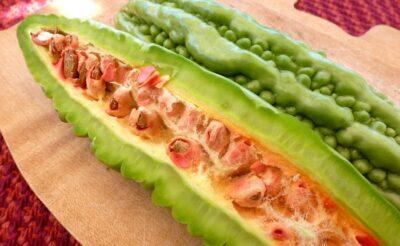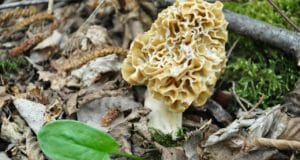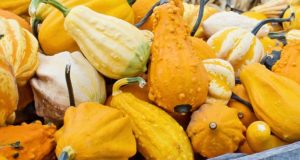
Image source: MyFeedZone.com
I once saw a guy on YouTube ranting on camera, complaining why doctors never told him about bitter melon and how it could help treat his diabetes. Indeed, lots of scientific findings have been surfacing lately, pointing to the hypoglycaemic effects of that acrid fruit.
Unfortunately, so many diabetics still have little knowledge of, nor have much choice about, any alternative treatments for their condition other than conventional medicine. In the United States, the diabetes drug industry was worth around $35 billion in 2013, and was estimated to hit $58 billion by 2018. So it’s not surprising that very few, if only a handful of mainstream physicians, are talking about natural remedies such as those offered by bitter melon.
Around the world, the number of diabetes cases continues to grow, with an estimated 381 million diabetics worldwide. Here in the Philippines, it’s also a major health problem. But good thing we have ampalaya, the local name for bitter melon. It has already been endorsed by our health department as a herbal medicine for diabetes. Though awareness and scientific evidence of its hypoglycaemic properties only circulated here probably 10 or so years ago, bitter melon has long and widely been used in Filipino cooking. It’s traditionally included in vegetable stews, omelettes and eaten raw in salad.
Bitter melon, or momordica charantia, goes by many names: bitter gourd, bitter squash, balsam pear and balsam apple in most English-speaking countries; karavel in India; and goya in Japan. It’s a perennial vine that grows in hot, humid climates like Asia, Africa, South America and the Caribbean. Its long, cucumber-like fruit has either a spiky or wrinkled, warty skin that looks totally unappealing. And its taste is just as unpleasant, especially if you’re the type who can’t stomach anything slightly bitter.
Without A Doubt The Best Kept Secret In Self-Reliance Gardening…
The gourd’s flesh is crunchy and watery like a chayote. It is often eaten unripe, while yet green, as its bitterness becomes even harsher as the fruit ripens and turns yellow-orange. How it earned its place in many cuisines around the world, I don’t know. But I do know that the pith inside the fruit, soft and white, and the pulp surrounding the seeds, which turn red when ripe, are also edible and much more palatable. The shoots and young leaves of the vine are also used as vegetables.
Across Asia and the Caribbean, bitter melon is enjoyed stir-fried, thrown into soups, stewed in spices or coconut milk to cover its bitter taste, or par-boiled then stuffed with ground meat. In China and Japan, it is used in place of hops as a bittering agent for beer. It is also consumed as herbal tea.
Medicinal benefits
In Japan where it plays a significant role in Okinawan cuisine, bitter melon is said to be the reason why many Okinawans live longer, healthier lives than the rest of the Japanese.
True enough, bitter melon has a long and impressive history of medicinal use in the East. Aside from diabetes, it aids in treating high blood pressure, high cholesterol, diarrhea, stomach cramps, hemorrhoids, fever, skin infections,painful menstruation, kidney stones, colic, malaria and glaucoma. It is known for its antiviral, anti-bacterial, anti-fungal and anti-inflammatory properties — which means it’s helpful in treating problems like measles, psoriasis, ringworm and gout pain. Natural healers also recognize the fruit for its ability to boost energy, strengthen immunity, heal wounds, balance hormonal levels, improve sleep, enhance libido, detoxify the liver and blood, improve circulation, promote milk flow, and alleviate respiratory problems like asthma, bronchitis and pharyngitis. It is also known as a mild laxative.
But in recent years, much research has been focused on its ability to treat both Type I and Type II diabetes.
Story continues below video
“Bitter gourd is not like most medicinal drugs, which are effective only in one target organ or tissue; rather, it influences glucose metabolism all over the body,” says Dr. Sandra Habicht of The Bitter Gourd Project, an international non-profit research initiative funded by the German Ministry for Economic Cooperation and Development. Habicht says bitter melon reduces the amount of glucose released into the blood by inhibiting the enzymes that break them down. It can also slow down the transport of sugar in the blood stream.
Different properties work to produceits hypoglycemic (or blood sugar reducing) effect. These are charantin, vicine, lectin, insulin-like polypeptide P (a plant insulin), cucurbutanoids, momordicin and oleanolic acids. Several animal and small-scale human studies have been done which showed blood glucose levels decreasing within 30 minutes after ingesting bitter melon, with effects lasting up to 12 hours.
There is also evidence to prove that bitter melon not only increases the number of cells that produce insulin in the pancreas, but also induces insulin secretion. Insulin is the natural hormone that regulates glucose in our blood. Patients with Type I diabetes, also called insulin-dependent diabetes, can benefit from this because their pancreas does not produce or secrete enough insulin. Although bitter gourd may reduce the amount of insulin injections necessary to manage this type, Habicht says it cannot replace the insulin treatment altogether or completely heal this form of the disease.
In Type 2 diabetes, known as insulin-independent or adult-onset diabetes, the body does not respond properly to insulin; it is “insulin resistant.” Studies that were done with Type 2 diabetic rats have shown that bitter gourd helps to prevent or reverse such resistance. This is acknowledged by the Memorial Sloan-Kettering Cancer Center, which says that bitter melon increases the uptake of blood glucose by the liver, fatty tissues and the muscles, stimulating them to convert glucose into glycogen, its storage form. These changes tend to reduce the levels of blood sugar and help lessen the demand on the pancreas for insulin, as well as improve glucose tolerance.
Type 2 diabetes is now practically an epidemic in the United States, occurring mostly in people who are overweight and sedentary. But those at high risk of developing this kind of diabetes have a good chance of avoiding the disease just by maintaining a normal weight, becoming active, and keeping a healthy diet — and, if I may add, incorporating bitter melon into it.
Story continues below video
By the way, there’s also scientific data showing bitter gourd can promote weight loss. Animal studies have demonstrated it can reduce visceral obesity caused by a high-fat diet, according to Dr. Dallas Clouatre, a nutritionist who writes for TotalHealthMagazine.com.
Anti-cancer, too
The London-based daily, Express.co.uk, reported that researchers from Saint Louis University in the US found bitter melon extracts capable of eliminating breast cancer cells and preventing them from growing and spreading. Many people in Asia consume the gourd in large quantities, so this may be indicative of the lower rates of many types of cancers here.Studies in Manila show bitter melon to have positive effects on not just breast cancer but also leukemia, prostate cancer and HIV. Elsewhere, extracts of the fruit have been found to inhibit the growth of Herpes simplex and Epstein Barr virus.
Culinary and nutrition
Bitter melons are rich in vitamins A, B and C; folate; calcium; iron; potassium and dietary fiber. They have twice the beta-carotene of broccoli, twice the calcium of spinach and twice the potassium of bananas.
Fresh bitter melons can be found in many Asian stores across the U.S., but juice, extracts, teas and pill supplements are also available online and in health food stores.
If you can get hold of a fruit, there’s a couple of things you can do to lessen its bitterness. One, you can soak the sliced gourd in salty water for half an hour before cooking or consuming; or, while cooking, refrain from stirring the pieces inside the pot often. When juicing, you can mix it with honey or any sweet fruit juice like apple, carrot or grape to mask its bitterness.
A word of caution
Too much consumption of bitter melon – more than 2 ounces or the equivalent of 2 melons a day – especially on an empty stomach could cause mild abdominal pain or diarrhea.
If you’re diabetic and considering complementing your medical treatment with bitter gourd, consult your doctor before consuming it on a regular basis as it may interact with your prescriptions.
Since it has also been shown to be an abortifacient, pregnant women should avoid eating too much of it as it may induce bleeding and contractions.
How to grow
Bitter gourd can grow as an annual in any region that has at least three and a half months of growing season. But it can also thrive as a perennial in US plant hardiness zones 10 and 11. Seeds are easy to grow, usually germinating within 1-2 weeks of sowing. The best temperature range is 70 to 90 degrees F, with six or more hours of sun per day. Average growing time is around 80 days.
Tell us your growing or culinary tips for bitter melon in the comments section below.
Sign up for Off The Grid News’ weekly email and get $600 worth of survival blueprints … free!
 Off The Grid News Better Ideas For Off The Grid Living
Off The Grid News Better Ideas For Off The Grid Living




